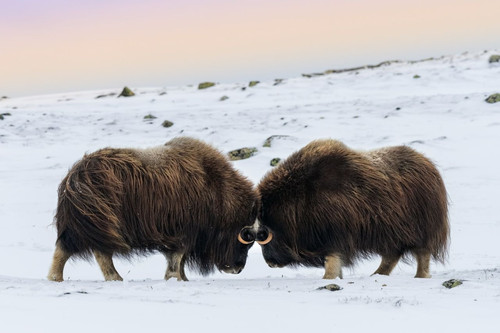Golden Snub-nosed Monkeys
See Our Perfect Planet: The Sun
 By Dominic Couzens
By Dominic Couzens19th January 2021
Dominic is a Naturetrek tour leader and one of Britain's
best known and most prolific natural history writers.
The BBC’s wonderful new series A Perfect Planet continued to enthral this week. I must confess, I never knew that every part of the world’s surface received the same amount of light every year – 4380 hours. But of course, as we all know, because of the tilt of the earth to 23.5° from the vertical, the day length varies, from 12 hours a day in the tropics all year round, to the seesawing of light and dark we only know too well in northern and southern parts of the earth. This week’s programme was all about those extremes.
At Naturetrek we love to take you to every corner of the earth. But we don’t plan to be on Ellesmere Island, close to the North Pole in the dead of winter, and we won’t be watching Saharan Silver Ants at a sand temperature of nearly 60°C either! But you can see Musk Oxen, Wolves and Arctic Hares with us, and go to the Sahara.
Ellesmere Island was an extraordinary ethereal landscape in the half-light, and the stand-off between the Wolves and Musk Oxen was dramatic stuff, not least because the Musk Ox looks so much like a remnant from an Ice Age, like a shrunken woolly mammoth (but just as well-armed, with a head used as a battering ram). The Musk Ox is an exceptionally difficult animal to see in the wild, but there is a herd in Norway and in Greenland (Scoresby Sound), both of which you can see on a Tailormade holiday with us (the latter being an exciting cruise – contact Georgie to enquire). And what about that enormous, rolling, scampering gathering of Arctic Hares? Amazing.

The one thing that every animal wishes to avoid in the winter is, of course, to freeze solid – unless, it seems, it’s a Wood Frog. This is a common amphibian in the north-eastern United States and you will probably come across it on a tour here or anywhere in Canada. In winter, its blood freezes and its heart stops, but it thaws out in only twelve hours. Almost immediately it is raring to go.
Personally, I would prefer to be a Wood Frog than a Golden Snub-nosed Monkey facing the winter. These animals are drop-dead gorgeous, with their expressive faces, but the colder seasons are a time of angst. The family groups, which live in Central China, including Sichuan, have to fight in the autumn to get access to their favourite nutritious food, pine-cones. But the losers face a tough winter feeding on leaves instead, and looked rather sorry for themselves, sitting alone in the snowfall!
Meanwhile, their relatives the Gibbons live the life of Riley in the tropical rainforests of Asia. Their day is a steady 12 hours throughout the year and, other than wet and dry seasons, much is predictable. Family groups know every single fig tree in their home range, because figs are the only plants that produce fruit all year round. With the sun on your back and a fig in your mouth, this seems pretty blissful.

It’s a more comfortable life than the extreme heats tolerated by the Silver Ants. These remarkable insects, among the fastest running on earth, feed partly on animals caught out in the sun and rendered moribund by the extreme heat (air temperature of 47-52°C). They only come out for 10 minutes a day, when ant-eating lizards seek the shade. They are looking for dead and dying insects, which they transport to their burrow in a rush.
A few animals have adapted to the seasons by travelling with them – many a migrating bird, insect or mammal does this. One such is the Sooty Shearwater, which breeds (among other places) on Snares Island, off the southern tip of New Zealand. Remarkably, the birds we witnessed setting off on their post-breeding migration travel 10,000 miles to the north, where they feed on the abundance of krill in the Bering Sea off the Aleutian Islands and Kamchatka in mid-summer. Here they often enjoy the abundance along with Humpback Whales, some 6,000 of which migrate here at the same time, having bred in the tropics.
If the sight of thousands of Sooty Shearwaters and Humpback Whales excites you, then a cruise to Kamchatka might be for you. And you can always enjoy the Shearwaters and local penguins on the Snares Islands with us as part of a tailormade cruise – as well as Gibbons in Asia, Snub-nosed Monkeys in Sichuan and many other delights highlighted by the series.
Tailormade tour to Norway or Greenland
China - Mountains, Monkeys & Terracotta Warriors
Thursday 14th April - Thursday 28th April 2022 - £4,995
Kamchatka & Chukotka - Russia's Ring of Fire
Sunday 20th June - Monday 5th July 2021 - £9,695



 Loading search...
Loading search...



